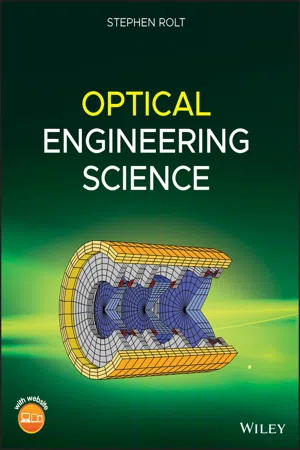
Optical Engineering Science
Stephen Rolt
- English
- ePUB (apto para móviles)
- Disponible en iOS y Android
Optical Engineering Science
Stephen Rolt
Información del libro
A practical guide for engineers and students that covers a wide range of optical design and optical metrology topics
Optical Engineering Science offers a comprehensive and authoritative review of the science of optical engineering. The book bridges the gap between the basic theoretical principles of classical optics and the practical application of optics in the commercial world. Written by a noted expert in the field, the book examines a range of practical topics that are related to optical design, optical metrology and manufacturing. The book fills a void in the literature by coving all three topics in a single volume.
Optical engineering science is at the foundation of the design of commercial optical systems, such as mobile phone cameras and digital cameras as well as highly sophisticated instruments for commercial and research applications.It spans the design, manufacture and testing of space or aerospace instrumentation to the optical sensor technology for environmental monitoring.Optics engineering science has a wide variety of applications, both commercial and research.This important book:
- Offers a comprehensive review of the topic of optical engineering
- Covers topics such as optical fibers, waveguides, aspheric surfaces, Zernike polynomials, polarisation, birefringence and more
- Targets engineering professionals and students
- Filled with illustrative examples and mathematical equations
Written for professional practitioners, optical engineers, optical designers, optical systems engineers and students, Optical Engineering Science offers an authoritative guide that covers the broad range of optical design and optical metrology topics and their applications.
Preguntas frecuentes
Información
1
Geometrical Optics
1.1 Geometrical Optics – Ray and Wave Optics


Índice
- Cover
- Preface
- Glossary
- About the Companion Website
- 1 Geometrical Optics
- 2 Apertures Stops and Simple Instruments
- 3 Monochromatic Aberrations
- 4 Aberration Theory and Chromatic Aberration
- 5 Aspheric Surfaces and Zernike Polynomials
- 6 Diffraction, Physical Optics, and Image Quality
- 7 Radiometry and Photometry
- 8 Polarisation and Birefringence
- 9 Optical Materials
- 10 Coatings and Filters
- 11 Prisms and Dispersion Devices
- 12 Lasers and Laser Applications
- 13 Optical Fibres and Waveguides
- 14 Detectors
- 15 Optical Instrumentation – Imaging Devices
- 16 Interferometers and Related Instruments
- 17 Spectrometers and Related Instruments
- 18 Optical Design
- 19 Mechanical and Thermo‐Mechanical Modelling
- 20 Optical Component Manufacture
- 21 System Integration and Alignment
- 22 Optical Test and Verification
- Index
- End User License Agreement